by Prof Michel Chossudovsky
Global Research
April 13, 2008
NOTICE: THIS WORK MAY BE PROTECTED BY COPYRIGHT
YOU ARE REQUIRED TO READ THE COPYRIGHT NOTICE AT THIS LINK BEFORE YOU READ THE FOLLOWING WORK, THAT IS AVAILABLE SOLELY FOR PRIVATE STUDY, SCHOLARSHIP OR RESEARCH PURSUANT TO 17 U.S.C. SECTION 107 AND 108. IN THE EVENT THAT THE LIBRARY DETERMINES THAT UNLAWFUL COPYING OF THIS WORK HAS OCCURRED, THE LIBRARY HAS THE RIGHT TO BLOCK THE I.P. ADDRESS AT WHICH THE UNLAWFUL COPYING APPEARED TO HAVE OCCURRED. THANK YOU FOR RESPECTING THE RIGHTS OF COPYRIGHT OWNERS.
The human rights issue has become the centerfold of media disinformation.
China is no model of human rights but neither are the US and its indefectible British ally, responsible for extensive war crimes and human rights violations in Iraq and around the World. The US and its allies, which uphold the practice of torture, political assassinations and the establishment of secret detention camps, continue to be presented to public opinion as a model of Western democracy to be emulated by developing countries, in contrast to Russia, Iran, North Korea and the People’s Republic of China.
Human Rights “Double Standards”
While China’s alleged human rights violations in relation to Tibet are highlighted, the recent wave of killings in Iraq and Palestine are not mentioned. The Western media has barely acknowledged the Fifth “anniversary” of Iraq’s “Liberation” and the balance sheet of the US sponsored killings and atrocities perpetrated against an entire population, in the name of a “global war on terrorism”.
There are more than 1.2 million Iraqi civilian deaths, 3 million wounded. The United Nations High Commission for Refugees (UNHCR) indicates a figure of 2.2 million Iraqi refugees who have fled their country and 2.4 million “internally displaced persons”:
“Iraq’s population at the time of the US invasion in March 2003 was roughly 27 million, and today it is approximately 23 million. Elementary arithmetic indicates that currently over half the population of Iraq are either refugees, in need of emergency aid, wounded, or dead.” (Dahr Jamail, Global Research, December 2007)
The Geopolitical Chessboard
There are deep-seated geopolitical objectives behind the campaign against the Chinese leadership.
US-NATO-Israeli war plans in relation to Iran are at an advanced state of readiness. China has economic ties as well as a far-reaching bilateral military cooperation agreement with Iran. Moreover, China is also an ally of Russia, Kazakhstan, the Kyrgyz Republic, Tajikistan and Uzbekistan in the context of the Shanghai Cooperation Organization (SCO). Since 2005, Iran has an observer member status within the SCO.
In turn, the SCO has ties to the Collective Security Treaty Organization (CSTO), an overlapping military cooperation agreement between Russia, Armenia, Belarus, Uzbekistan, Kazakhstan, the Kyrgyz Republic, Tajikistan.
In October of last year the Collective Security Treaty Organization (CSTO) and the Shanghai Cooperation Organization (SCO) signed a Memorandum of Understanding, laying the foundations for military cooperation between the two organizations. This SCO-CSTO agreement, barely mentioned by the Western media, involves the creation of a full-fledged military alliance between China, Russia and the member states of SCO/CSTO. It is worth noting that the SCTO and the SCO held joint military exercises in 2006, which coincided with those conducted by Iran. (For further details see Michel Chossudovsky, Russia and Central Asian Allies Conduct War Games in Response to US Threats, Global Research, August 2006)
In the context of US war plans directed against Iran, the US is also intent upon weakening Iran’s allies, namely Russia and China. In the case of China, Washington is seaking to disrupt Beijing’s bilateral ties with Tehran as well as Iran’s rapprochement with the SCO, which has its headquarters in Beijing.
China is an ally of Iran. Washington’s intention is to use Beijing’s alleged human rights violations as a pretext to target China, an ally of Iran.
In this regard, a military operation directed against Iran can only succeed if the structure of military alliances which link Iran to China and Russia is disrupted. This is something which German Chancellor Otto von Bismarck understood in relation to the structure of competing military alliances prevalent prior to World War I. The Triple Alliance was an agreement between Germany, the Austro-Hungarian Empire and Italy formed in 1882. In 1907, an Anglo-Russian agreement paved the way for the formation of the Triple Entente made up of France, the U.K. and Russia.
The Triple Alliance ultimately came to an end in 1914, when Italy withdrew from the alliance and declared its neutrality, thereby paving the way for the outbreak of World War I.
History points to the importance of competing military alliances. In the present context, the US and its NATO partners are seaking to undermine the formation of a cohesive Eurasian SCO-CSTO military alliance, which could effectively challenge and contain US-NATO military expansionism in Eurasia, combining the military capabilities not only of Russia and China, but also those of several former Soviet republics including Belarus, Armenia, Kazakhstan, Tajikistan Uzbekistan and the Kyrgyz Republic.
Encircling China
With the exception of its Northern frontier which borders on the Russian Federation, Mongolia and Kazakhstan, China is surrounded by US military bases.
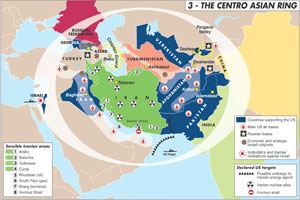
The Centro-Asian Ring
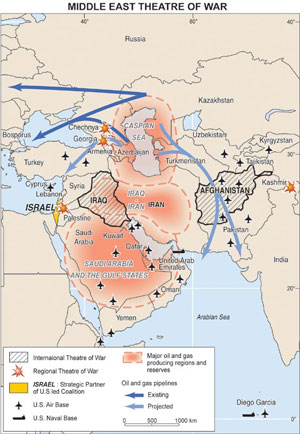
Middle East Theatre of War
The Eurasian Corridor
Since the 2001 invasion and occupation of Afghanistan, the US has a military presence on China’s Western frontier, in Afghanistan and Pakistan. The U.S. is intent upon establishing permanent military bases in Afghanistan, which occupies a strategic position bordering on the former Soviet republics, China and Iran.
Moreover, the US and NATO have also established since 1996, military ties with several former Soviet republics under GUUAM (Georgia, Ukraine, Uzbekistan, Azerbaijan and Moldava). In the post 9/11 era, Washington has used the pretext of the “global war against terrorism” to further develop a U.S. military presence in GUUAM countries. Uzbekistan withdrew from GUUAM in 2002.(The organization is now referred to as GUAM).
China has oil interests in Eurasia as well as in sub-Saharan Africa, which encroach upon Anglo-American oil interests.
What is at stake is the geopolitical control over the Eurasian corridor.
In March 1999, the U.S. Congress adopted the Silk Road Strategy Act, which defined America’s broad economic and strategic interests in a region extending from the Eastern Mediterranean to Central Asia. The Silk Road Strategy (SRS) outlines a framework for the development of America’s business empire along an extensive geographical corridor.
The successful implementation of the SRS requires the concurrent “militarization” of the entire Eurasian corridor as a means to securing control over extensive oil and gas reserves, as well as “protecting” pipeline routes and trading corridors. This militarization is largely directed against China, Russia and Iran.
The militarization of the South China Sea and of the Taiwan Straits is also an integral part of this strategy which, in the post 9/11 era, consists in deploying “on several fronts”.
Moreover, China remains in the post-Cold War era a target for a first strike nuclear attack by the US.
In the 2002 Nuclear Posture Review (NPR), China and Russia are identified along with a list of “rogue States” as potential targets for a pre-emptive nuclear attack by the US. China is listed in the NPR as “a country that could be involved in an immediate or potential contingency”. Specifically, the Nuclear Posture Review lists a military confrontation over the status of Taiwan as one of the scenarios that could lead Washington to use nuclear weapons against China.
China has been encircled: The U.S. military is present in the South China Sea and the Taiwan Straights, in the Korean Peninsula and the Sea of Japan, as well as in the heartland of Central Asia and on the Western border of China’s Xinjiang-Uigur autonomous region. Moreover, as part of the encirclement of China, “Japan has gradually been amalgamating and harmonizing its military policies with those of the U.S. and NATO.” (See Mahdi Darius Nazemroaya, Global Military Alliance: Encircling Russia and China, Global Research, 10 May 2007)
Weakening China from within: Covert Support to Secessionist Movements
Consistent with its policy of weakening and ultimately fracturing the People’s Republic of China, Washington supports secessionist movements both in Tibet as wall as in the Xinjiang-Uigur autonomous region which borders onto North Eastern Pakistan and Afghanistan.
In Xinjiang-Uigur, Pakistani intelligence (ISI), acting in liaison with the CIA, supports several Islamist organizations. The latter include the Islamic Reformist Party, the East Turkestan National Unity Alliance, the Uigur Liberation Organization and the Central Asian Uigur Jihad Party. Several of these Islamic organizations have received support and training from Al Qaeda, which is a US sponsored intelligence asset. The declared objective of these Chinese-based Islamic organizations is the “establishment of an Islamic caliphate in the region” (For further details see Michel Chossudovsky, America’s War on Terrorism, Global Research, Montreal, 2005, Chapter 2).
The caliphate would integrate Uzbekistan, Tajikistan, Kyrgyzstan (West Turkestan) and the Uigur autonomous region of China (East Turkestan) into a single political entity.
The “caliphate project” encroaches upon Chinese territorial sovereignty. Supported by various Wahabi “foundations” from the Gulf States, secessionism on China’s Western frontier is, once again, consistent with U.S. strategic interests in Central Asia. Meanwhile, a powerful U.S.-based lobby is channeling support to separatist forces in Tibet.
By tacitly promoting the secession of the Xinjiang-Uigur region (using Pakistan’s ISI as a “go-between”), Washington is attempting to trigger a broader process of political destabilization and fracturing of the People’s Republic of China. In addition to these various covert operations, the U.S. has established military bases in Afghanistan and in several of the former Soviet republics, directly on China’s Western border.
The militarization of the South China Sea and of the Taiwan Straits is also an integral part of this strategy.(Ibid)
The Lhasa Riots
The violent riots in Tibet’s capital in mid-March were a carefully staged event. In their immediate aftermath, a media disinformation campaign supported by political statements by Western leaders directed against China was launched.
There are indications that US intelligence played a behind the scenes role in what several observers have described as a carefully premeditated operation.(See our analysis below).
The Lhasa event in mid-March was not a spontaneous “peaceful” protest movement as described by the Western media The riots involving a gang of mobsters were premeditated. They had been carefully planned. Tibetan activists in India associated with the Dalai Lama’s government in exile “hinted they were indeed expecting the disturbances. But they refuse to elaborate how they knew or who their collaborators were” (Guerilla News)
The images do not suggest a mass protest rally but rather a rampage led by a few hundred individuals. Buddhist monks were involved in the rampage. According to China Daily (March 31, 2008), the Tibetan Youth Congress (TYC) based in India, considered by China as a “hard-line organization” affiliated to the Dalai Lama, was also behind the violence. The TYC’s training camps are funded by the National Endowment for Democracy (NED). (See the text of the Congressional Hearings regarding NED support to the TYC)
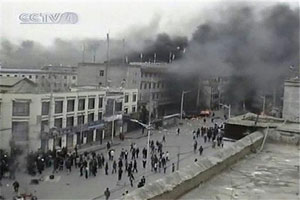
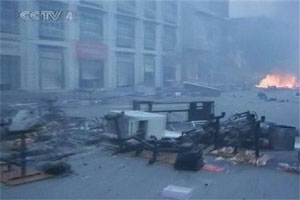
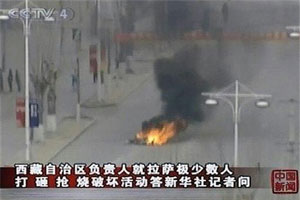
VIDEO: THE LHASA RIOTS (CCTV.com China State TV) [UNAVAILABLE]
Global Research Editor’s Comment
The images do not suggest a mass protest rally but rather a rampage led by a few hundred individuals. Buddhist monks were involved in the rampage. According to China Daily (March 31, 2008), the Tibetan Youth Congress (TYC), considered to a “hard-line organization” affiliated to the Dalai Lama, was also behind the violence.
At least ten people were burned to death as a result of the criminal rampage, according to statements of the regional government. These statements were confirmed by several eyewitness reports. According to a China Daily report;“five shop assistants at a clothing store were burnt to death before they had any chance to escape. A 1.7-meter-tall man named Zuo Yuancun was torched down to chunks of horrid flesh and skeletons. A migrant worker had his liver stabbed and bled by mobsters. A woman was beaten hard by the attackers and had her ear sliced off.”
(China Daily, March 22, 2008
http://english.peopledaily.com.cn/90001 ... 78826.html
Meanwhile, the Western media described the looting and arson as a “peaceful demonstration” which the Chinese authorities had attempted to suppress.
Now look at how the pro-Western covered the same event, described as a small peaceful event.
Who is telling the truth.
“Peaceful Demonstrations” in Lhasa
The original source of this article is CCTV.com China State TV
Copyright © CCTV9, CCTV.com China State TV, 2008
VIDEO: The Tibet Riots: What Really Happened - [UNAVAILABLE]
Video footage confirms that civilians were stoned, beaten and in some cases killed. Most of the victims were Han Chinese. At least ten people were burned to death as a result of acts of arson, according to statements by the Tibet government. These statements were confirmed by several eyewitness reports. According to a People’s Daily report:
“five shop assistants at a clothing store were burnt to death before they had any chance to escape. A 1.7-meter-tall man named Zuo Yuancun was torched down to chunks of horrid flesh and skeletons. A migrant worker had his liver stabbed and bled by mobsters. A woman was beaten hard by the attackers and had her ear sliced off.” (People’s Daily, March 22, 2008)
Meanwhile, the Western media casually described the looting and arson as a “peaceful demonstration” which the Chinese authorities suppressed with the use of force. There are no accurate reports (both from Chinese and Western news sources) on the number of casualties resulting from the Chinese police operation launched to repress the riots. Western press reports point to a large scale deployment of more than 1000 soldiers and police in armored vehicles in the Tibetan capital.
Businesses, schools were attacked, cars were set on fire. According to Chinese reports, there are 22 dead and 623 injured. “Rioters set fire at more than 300 locations, mostly private houses, stores and schools, and smashed vehicles and damaged public facilities.”
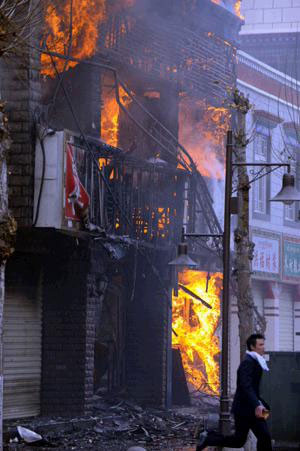
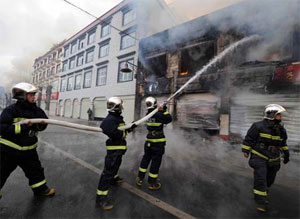
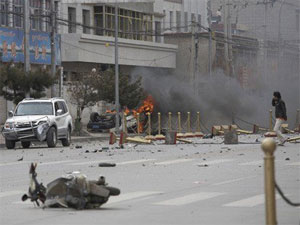
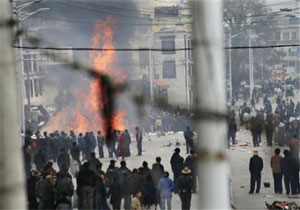
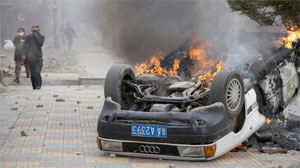
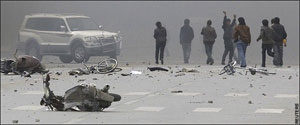
The planning of the riots was coordinated with the media disinformation campaign, which accused the Chinese authorities of having instigated the looting and arson. The Dalai Lama accused Beijing of “disguising its troops as monks” to give the impression that Buddhist monks were behind the riots. The claims were based on a four year old photograph of soldiers dressing up as monks in a theatrical stage performance (See South China Morning Post, 4 April 2008).
The mainland newspaper {People’s Daily] said the security forces quelling riots in Lhasa could not possibly have been wearing the uniforms shown in the photograph because they were summer uniforms, unsuitable for the cold March weather.
It also said the PAP had changed to new uniforms in 2005, which feature shoulder emblems. The armed officers shown in the photograph were in old-style uniforms which had been phased out after 2005. … Xinhua said the photograph was taken during a performance years ago, when soldiers borrowed robes from monks before performing on stage. (Ibid)
The Dalai Lama’s claim that the Chinese authorities had instigated the riots, quoted in the Western media, is supported by a statement of a former Communist Party official Mr. Ruan Ming who “claims the CCP carefully staged the incidents in Tibet in order to force the Dalai Lama to resign and to justify future repression of the Tibetans. Mr. Ruan Ming was a speechwriter for former CCP General Secretary Hu Yaobang.” (quoted in The Epoch Times)
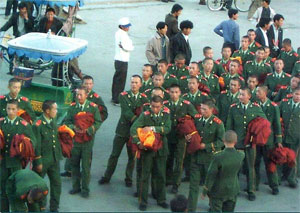
2003 photograph used by the media to accuse China of having deliberately instigated the riots. “This [2003] photo was apparently made when soldiers were ordered to put on robes to play as actors in a movie.” See http://buddhism.kalachakranet.org/chine ... -tibet.htm
The Role of US Intelligence
The organization of the Lhasa riots are part of a consistent pattern. They constitute an attempt to trigger ethnic conflict in China. They serve US foreign policy interests.
To what extent has US intelligence played an undercover role in the current wave of protests regarding Tibet?
Given the covert nature of intelligence operations, there is no tangible evidence of direct CIA involvement. However, there are various Tibetan organizations linked to the Tibet “government in exile” which are known to be supported by the CIA and/or by the CIA’s civilian front organization, the National Endowment for Democracy (NED).
The CIA’s involvement in channeling covert support to the Tibetan secessionist movement goes back to the mid-1950s. The Dalai Lama was on the CIA’s payroll from the late 1950s until 1974:
The CIA conducted a large scale covert action campaign against the communist Chinese in Tibet starting in 1956. This led to a disastrous bloody uprising in 1959, leaving tens of thousands of Tibetans dead, while the Dalai Lama and about 100,000 followers were forced to flee across the treacherous Himalayan passes to India and Nepal.
The CIA established a secret military training camp for the Dalai Lama’s resistance fighters at Camp Hale near Leadville, Colorado, in the US. The Tibetan guerrillas were trained and equipped by the CIA for guerrilla warfare and sabotage operations against the communist Chinese.
The US-trained guerrillas regularly carried out raids into Tibet, on occasions led by CIA-contract mercenaries and supported by CIA planes. The initial training program ended in December 1961, though the camp in Colorado appears to have remained open until at least 1966.
The CIA Tibetan Task Force created by Roger E McCarthy, alongside the Tibetan guerrilla army, continued the operation codenamed “ST CIRCUS” to harass the Chinese occupation forces for another 15 years until 1974, when officially sanctioned involvement ceased.
McCarthy, who also served as head of the Tibet Task Force at the height of its activities from 1959 until 1961, later went on to run similar operations in Vietnam and Laos.
By the mid-1960s, the CIA had switched its strategy from parachuting guerrilla fighters and intelligence agents into Tibet to establishing the Chusi Gangdruk, a guerrilla army of some 2,000 ethnic Khamba fighters at bases such as Mustang in Nepal.
This base was only closed down in 1974 by the Nepalese government after being put under tremendous pressure by Beijing.
After the Indo-China War of 1962, the CIA developed a close relationship with the Indian intelligence services in both training and supplying agents in Tibet.” (Richard Bennett, Tibet, the ‘great game’ and the CIA, Global Research, March 2008)
The National Endowment for Democracy (NED)
The National Endowment for Democracy (NED), which channels financial support to pro-US opposition groups around the World has played a significant role in triggering “velvet revolutions” which serve Washington’s geopolitical and economic interests.
The NED, although not formally part of the CIA, performs an important intelligence function within the arena of civilian political parties and NGOs. It was created in 1983, when the CIA was being accused of covertly bribing politicians and setting up phony civil society front organizations. According to Allen Weinstein, who was responsible for setting up the NED during the Reagan Administration: “A lot of what we do today was done covertly 25 years ago by the CIA.” (‘Washington Post’, Sept. 21, 1991).
The NED operates through four core institutes: the National Democratic Institute for International Affairs (NDIIA), the International Republican Institute (IRI), the American Center for International Labor Solidarity (ACILS), and the Center for International Private Enterprise.
The NED provided funds to the “civil society” organizations in Venezuela, which initiated an attempted coup against President Hugo Chavez. In Haiti, the NED supported the opposition groups behind the armed insurrection which contributed to unseating President Bertrand Aristide in February 2004. The coup d’ Etat in Haiti was the result of a carefully staged military-intelligence operation. (See Michel Chossudovsky, The Destabilization of Haiti, Global Research, February 2004)
The NED funds a number of Tibet organizations both within China and abroad. The most prominent pro-Dalai Lama Tibet independence organization funded by the NED is the International Campaign for Tibet (ICT), founded in Washington in 1988. The ICT has offices in Washington, Amsterdam, Berlin and Brussels. Distinct from other NED funded Tibet organizations, the ICT has a close cozy and ” overlapping” relationship with the NED and the US State Department::
Some of ICT’s directors are also integral members of the ‘democracy promoting’ establishment, and include Bette Bao Lord (who is the chair of Freedom House, and a director of Freedom Forum), Gare A. Smith (who has previously served as principal deputy assistant secretary in the U.S. Department of State’s Bureau of Democracy, Human Rights and Labor), Julia Taft (who is a former director of the NED, the former U.S. Assistant Secretary of State and Special Coordinator for Tibetan Issues, has worked for USAID, and has also served as the President and CEO of InterAction), and finally, Mark Handelman (who is also a director of the National Coalition for Haitian Rights, an organization whose work is ideologically linked to the NED’s longstanding interventions in Haiti).
The ICT’s board of advisors also presents two individuals who are closely linked to the NED, Harry Wu, and Qiang Xiao (who is the former executive director of the NED-funded Human Rights in China).
Like their board of directors, ICT’s international council of advisors includes many ‘democratic’ notables like Vaclav Havel, Fang Lizhi (who in 1995 – at least – was a board member of Human Rights in China), Jose Ramos-Horta (who serves on the international advisory board for the Democracy Coalition Project), Kerry Kennedy (who is a director of the NED-funded China Information Center), Vytautas Landsbergis (who is an international patron of the British-based neoconservative Henry Jackson Society – see Clark, 2005), and until her recent death, the “mid-wife of the neocons” Jeane J. Kirkpatrick (who was also linked to ‘democratic’ groups like Freedom House and the Foundation for the Defense of Democracies). (Michael Barker, “Democratic Imperialism”: Tibet, China, and the National Endowment for Democracy Global Research, August 13, 2007)
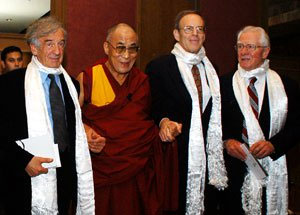
(L to R) Elie Weisel, The Dalai Lama, NED chairman Carl Gershman, and Lowell Thomas Jr. (Washington DC 2005)
Other NED funded Tibet organizations include the Students for a Free Tibet (SFT) referred to earlier. The SFT was founded in 1994 in New York City “as a project of US Tibet Committee and the NED-financed International Campaign for Tibet (ICT). The SFT is most known for unfurling a 450 foot banner atop the Great Wall in China; calling for a free Tibet.” (F. William Engdahl, Risky Geopolitical Game: Washington Plays ‘Tibet Roulette’ with China, Global Research, April 2008).
The SFT together with five other Tibet organizations proclaimed last January “the start of a ‘Tibetan people’s uprising” … and co-founded a temporary office in charge of coordination and financing.” ( Ibid)
“The NED also funds the Tibet Multimedia Center for “information dissemination that addresses the struggle for human rights and democracy in Tibet,” also based in Dharamsala. And the NED finances the Tibetan Center for Human Rights and Democracy.(Ibid)
There is a division of tasks between the CIA and the NED. While the CIA provides covert support to armed paramilitary rebel groups and terrorist organizations, the NED finances “civilian” political parties and non governmental organizations with a view to instating American “democracy” around the World.
The NED constitutes, so to speak, the CIA’s “civilian arm”. CIA-NED interventions in different part of the World are characterized by a consistent pattern, which is applied in numerous countries.
PsyOp: Discrediting the Chinese Leadership
The short-term objective is to discredit the Chinese leadership in the months leading up to the Beijing Olympic games, while also using the Tibet campaign to divert public opinion from the Middle East war and the war crimes committed by the US, NATO and Israel.
China’s alleged human rights violations are highlighted as a distraction, to provide a human face to the US led war in the Middle East.
The US sponsored war plans directed against Iran are now acknowledged and justified due to Tehran’s noncompliance with the demands of the “international community”.
With Tibet making the headlines, the real humanitarian crisis in the Middle East is not front page news.
More generally, the issue of human rights is distorted: realities are turned upside down, the extensive crimes committed by the US and its coalition partners are either concealed or justified as a means to protecting society against terrorists.
A “double standards” in the assessment of human rights violations has been instated. In the Middle East, the killing of civilians is categorized as collateral damage. It is justified as part of the “global war on terrorism”. The victims are said to be responsible for their own deaths.
The Olympic Torch
Carefully timed demonstrations on China’s human rights violations in Western capitals have been set in motion.
A partial boycott of the Olympic games seems to be underway. French Foreign Minister Bernard Kouchner (a strong protagonist of US interests who has a relationship to the Bilderbergs), has called for a boycott of the opening ceremonies of the Olympics. Kouchner said the idea should be discussed at a meeting of EU foreign ministers
The Olympic torch was lit at a ceremony in Greece, which was disrupted by “pro-Tibet activists”. The event was sponsored by “Reporters Without Borders”, an organization known to have links to US intelligence. (See, Diana Barahona, Reporters Without Borders Unmasked, May 2005). “Reporters Without Borders” also receives support for the National Endowment for Democracy (NED).
The Olympic Torch is symbolic. The Psychological operation (PsyOp) consists in targeting the Olympic torch in the months leading up the Beijing Olympic games.
At each phase of this process, the Chinese leadership is denigrated by the Western media.
Global Economic Implications
The Tibet campaign directed against the Chinese leadership could backlash.
We are at the crossroads of the most serious economic and financial crisis of modern history. The unfolding economic crisis bears a direct relationship to the US sponsored military adventure in the Middle East and Central Asia.
China plays a strategic role with regard to US military expansionism. So far it has not exercised its veto power in the United Nations Security Council in relation to the several US sponsored UNSC resolutions directed against Iran.
China also plays a central role in the global economy and financial system.
Resulting from an accumulated trade surplus with the US, China’s now holds 1.5 trillion dollars worth of US debt instruments (including US Treasury bills). It has the ability to significantly disrupt international currency markets. The US dollar would plunge to even lower levels, were China to sell off its dollar denominated debt holdings.(For further details see: F. William Engdahl, op cit)
Moreover, China is the largest producer of a wide range of manufactured goods which constitute, for the West, a significant share of monthly household consumption. Western retail giants rely on the continued and uninterrupted flow of cheap labor industrial commodities from China.
For the Western countries, China’s insertion into the structures of global trade, investment, finance and intellectual property rights under the World Trade Organization (WTO) is absolutely crucial. Were Beijing to decide to curtail its “Made in China” manufacturing exports to the US, America’s fragile and declining manufacturing base would not be able to fill the gap, at least in the short run.
Moreover, the US and its coalition partners including the UK, Germany, France and Japan have important investment interests in China. In 2001, the US and China signed a bilateral trading agreement prior to the accession of China to the WTO. This agreement allows US investors, including the major Wall Street financial institutions, to position themselves in Shanghai’s financial and trading system as well as in China’s domestic banking market.
While China is, in some regards, the West’s “cheap labor industrial colony”, China’s relationship to the global trading system is by no means cast in steel.
China’s relationship to global capitalism has its roots in the “Open Door Policy” initially formulated in 1979. (Michel Chossudovsky, Towards Capitalist Restoration. Chinese Socialism after Mao, Macmillian, London, 1986, chapters 7 and 8)
Since the 1980s, China has become the main supplier of industrial goods to Western markets. Any threat against China and/or military venture directed against China’s Eurasian allies including Iran could potentially disrupt China’s extensive trade in manufactured goods.
China’s export oriented industrial base is the source of tremendous wealth formation in the advanced capitalist economies. Where does the wealth of the Walton family, owners of WalMart, originate? WalMart does not produce anything. It imports cheap labor commodities “Made in China” and resells them in the US retail market at up to ten times their factory price.
This process of “import led development” has allowed the Western “industrialised” countries to close down a large part of their manufacturing outlets. In turn, China’s industrial sweat shops serve to generate multibillion dollar profits for Western corporations, including the retail giants, which purchase and/or outsource their production to China.
Any threat of a military nature directed against China could have devastating economic consequences, far beyond the familiar upward spiral in the price of crude oil.
Michel Chossudovsky is Director of the Centre for Research on Globalization (CRG). He is the author of several international best-sellers including The Globalization of Poverty and the New World Order, Global Research, 2003 and America’s “War on Terrorism”, Global Research, 2005. He is a contributor to the Encyclopedia Britannica. His writings have been translated into more than 20 languages.
Michel Chossudovsky is also the author of the first comprehensive study on the restoration of capitalism in China, published more than twenty years ago. Michel Chossudovsky, Towards Capitalist Restoration. Chinese Socialism after Mao, Macmillian, London, 1986. He has recently returned from a visit to China. He was in Shanghai and Beijing in March 2008.
Michel Chossudovsky, America’s “War on Terrorism”, Global Research, Montreal 2005
